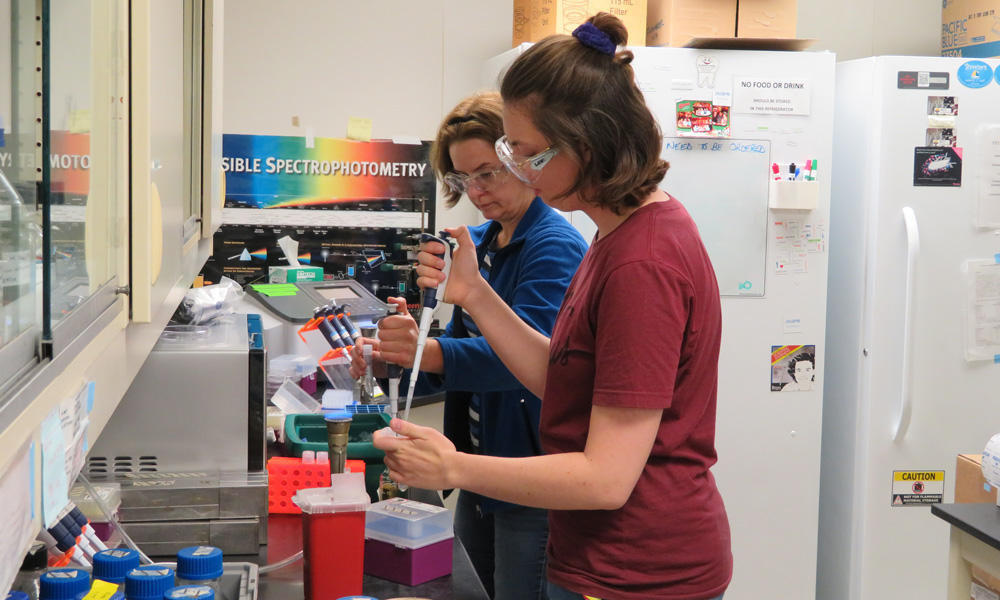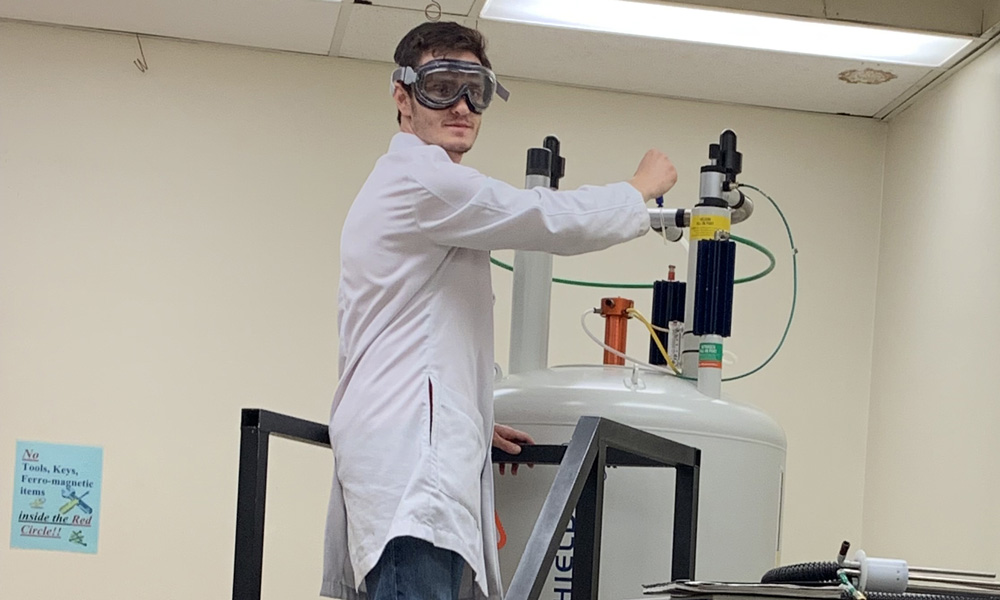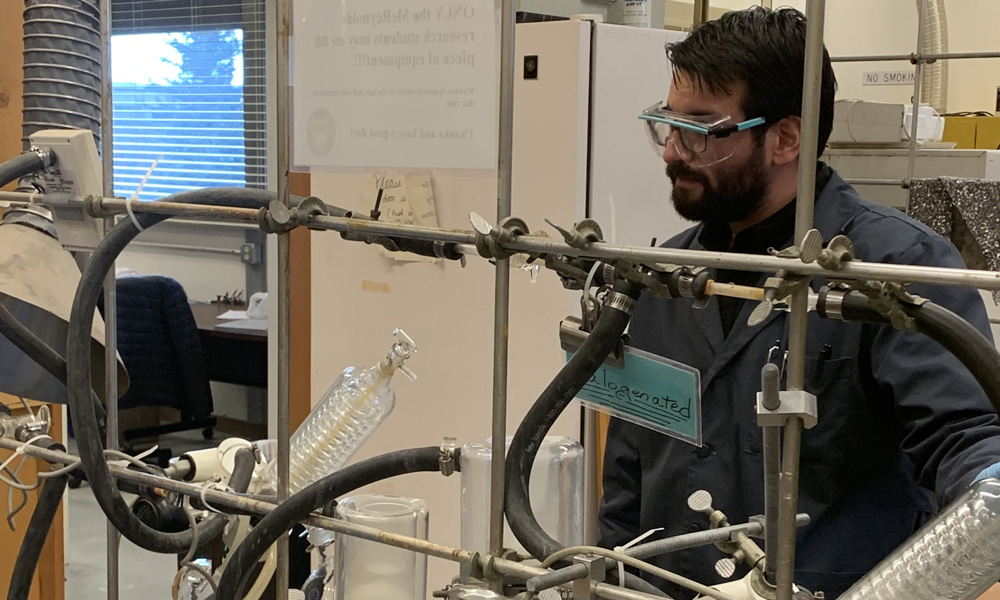The CSU operates the Program for Education and Research in Biotechnology (CSUPERB) as a community of practice for faculty and students from all 23 CSU campuses. CSUPERB catalyzes collaborative CSU student and faculty research, innovates educational practices and partners with the life sciences industry. CSUPERB’s definition of biotechnology is quite broad, intentionally mirroring the highly partnered, multidisciplinary nature of the field. Each year, CSUPERB involves and supports CSU faculty and students in all disciplines related to the current practice of biotechnology, including but not limited to life sciences, physical sciences, clinical sciences, math, computer science, agricultural science, engineering and business.
Creating Fundamental Building Blocks to Student Learning and Success in Biotechnology

DNA damage happens continuously in living cells and much of it is unavoidable. In human beings, failure to repair DNA damage results in genetic mutations and can lead to cancer. As an example, more than 90 percent of melanoma skin cancers are due to skin cell damage from ultraviolet radiation from exposure to sunlight. The Centers for Disease Control reports that rates are increasing for melanoma, the deadliest form of skin cancer. In 1982, there were 11.2 cases per 100,000 people; in 2011, that rate increased to 22.7 cases. At this point, scientists and physicians know the cause of most skin cancers and recommend preventative measures, but we still need effective therapies to treat the disease.
To help understand the key molecules and pathways that direct DNA repair, Dr. Paula Fischhaber’s group at California State University, Northridge focuses on proteins found in baker’s yeast (S. cerevisiae). Compared with human cells, yeast cells provide a simple model system for study, but they contain most of the DNA repair mechanisms found in more complicated systems. The group uses microscopy, genetics and other biochemical methods to understand how cells choose the most appropriate DNA repair pathway to avoid burdensome levels of mutations that could otherwise give rise to cancer.
The fundamental studies’ importance has been underscored by continual grant support, starting in 2007, from the National Institutes of Health to Dr. Fischhaber’s group. Over the years, the NIH funding not only led to nine publications from the 54 undergraduate and 18 master’s students trained in the lab, but also a notable source of successful students who moved on to graduate school and biotechnology jobs. Coming full circle, Dr. Armen Mardiros, Fischhaber’s first master’s student, was invited back to the 31st Annual CSU Biotechnology Symposium as a featured speaker; he’s now the director of translational oncology at Allogene in south San Francisco. Several Fischhaber group members have been CSUPERB Award finalists and two students—Justin Karlin and Fred Fregoso— won the Don Eden Graduate Student Research Award in 2010 and 2019, respectively. Dr. Karlin is now practicing as a physician in Los Angeles; Fregoso is in the molecular biochemistry and biophysics doctoral program at the University of Pennsylvania.
Fischhaber has been involved in CSUPERB governance since arriving at CSUN, serving as a Faculty Consensus Group member, and she was elected in 2018 to serve as the deputy chair. Fischhaber recognized that, even with federal grant funding, she was unable to offer apprenticeship-style research experiences to all interested students. She’s taken a leadership role advocating and advancing course-based undergraduate research experiences (CUREs) within the CSUPERB community. Piloted in 2018, the CSUPERB CUREs network now involves more than 91 faculty members from 22 campuses in workshops, webinars and an online community. CUREs offers course-based discovery research experiences and experiential learning which, if well-executed, can result in student engagement, learning outcomes and skill-building similar to research apprenticeships. The CSUPERB CUREs network, led by Fischhaber, hopes to see CSU faculty, administrators, departments and campuses design effective ways to incorporate experiential learning for all STEM students across the curriculum. She explains: “Hands-on research experiences provide the deep mentoring that is vitally important to STEM students’ personal growth and professional development. The CSU should build on programs and infrastructure that will enable increased faculty mentorship, such as those promoted by CSUPERB.”
Navigating Challenges of Becoming an Impactful Teacher-Mentor-Scholar

Between 2010 and 2016, the annual number of new HIV diagnoses decreased nine percent in the United States. The Centers for Disease Control estimates that more than one million people in the U.S. had HIV at the end of 2016, but one in seven do not know they have the infection and unknowingly can spread the disease. No cure exists for HIV yet, but drugs are used to slow disease progression in infected patients. Meanwhile, scientists and physicians around the world continue to work on preventive interventions so that the virus never enters a patient’s body.
After joining the CSU, Dr. Katherine McReynolds, professor of chemistry at Sacramento State University, won funding from the National Institute of Allergy and Infectious Diseases to work on new HIV prevention strategies. Her research group is expert in making unique carbohydrate (sugar) macromolecules that might prevent the HIV virus from infecting host cells. But in 2011 she faced a gap in funding and turned to the CSUPERB Research Development seed grant program to support lab operations and student research activities. The lab needed to innovate and improve the process used to make the complicated macromolecular structures. Dr. McReynolds also used the time to develop a collaboration with researchers at Duke University who had the capability to test her group’s molecules against live HIV virus. Based on advice McReynolds received from NIH-funded researchers within the CSUPERB community and from program officers at NIH, she targeted her new proposal to a National Institute of General Medical Sciences (NIGMS) grant program aimed at funding research groups at regional comprehensive universities like Sacramento State. The strategy was successful; the McReynolds group won the first NIH SCORE grant awarded to the campus.
Today the McReynolds lab is one of the busiest chemistry groups on campus, involving on average 10 undergraduates and three master’s students. McReynolds not only involves students in her scholarship, but also elevates them to gain recognition and showcase their contributions to the research enterprise. McReynolds nominates students in her laboratory for the very competitive, university-wide scholarships and awards sponsored by CSUPERB. As a result, her Sacramento State students have won seven Doris A. Howell–CSUPERB Student Research Scholarships; only 11 are awarded each year. Cory Vierra, a master’s student in the McReynolds lab, was a 2016 Howell Scholar. The depth of his research expertise in carbohydrate chemistry as well as his work on a real-world problem worth solving, led to a job with a startup biotechnology company, BCD Bioscience, in Sacramento.
McReynolds frequently credits the CSUPERB community with the student mentoring and research track record she’s built at Sacramento State. She found collaborators and peer mentors within the CSU who helped her navigate the challenges inherent in becoming an impactful teacher-mentor- scholar. As a result, she became involved in CSUPERB governance councils and was elected chair of the Faculty Consensus Group in 2018. As chair, McReynolds is focused on giving back to the CSU’s biotechnology community by developing professional development programs. She inaugurated the Faculty Short Talk series at the annual CSU Biotechnology Symposium to raise the profile of CSUPERB-funded faculty university-wide. She co-organized a 2019 new faculty workshop to help teacher-scholars hit the ground running on CSU campuses, bringing NIGMS Program Director Anissa J. Brown to California to consult one-on-one with faculty interested in writing NIH grant proposals. Most recently, she spearheaded CSUPERB efforts to reconnect with CSU alumni to smooth the path for student researchers as they leave to start biotechnology careers.
Innovative Learning Spaces Open Opportunities for Student Scientists

Dr. George Vourlitis’ research group measures the effects of human activities—including land use and land cover change, atmospheric pollution and climate change—on our terrestrial ecosystems. These issues “are interesting and complicated, and as a result, generate a lifetime of interesting research questions [related to] water quantity and quality, biodiversity, carbon storage and erosion control just to name a few,” he said. Dr. Vourlitis received a 2017 Research Development grant to learn new DNA-based, metabolomic research tools and demonstrate their application to his research program. Because the environmental monitoring field is increasingly adopting DNA-based methods, CSUPERB has seen a large increase in grant applications from ecology and environmental sciences faculty and students.
The CSUPERB grant allowed the Vourlitis group to measure how long-term nitrogen addition affected the soil microbial community of local chaparral and coastal sage scrub shrublands. The grant “funded the master’s thesis of my graduate student, Tim Grant, and because I am an ecologist with little direct experience in soil metagenomics, I partnered with Dr. [Arun] Sethuraman to help,” Vourlitis said. Sethuraman, an assistant professor in biological sciences at CSU San Marcos, runs a population genetics research program and brought next-generation DNA sequencing expertise when he joined the faculty in 2016. Based on their joint project and preliminary data collected by Grant, Vourlitis and Sethuraman wrote a proposal to the United States Department of Agriculture to fund course-based undergraduate research (CURE) in a molecular ecology class.
The new Molecular Ecology CURE is a combination of lecture, field work and lab. Vourlitis and Sethuraman team-teach the class, offered every spring at CSU San Marcos. “Data collected as part of this class were stellar, and Dr. Sethuraman and I feel that there are two to three possible publications,” Vourlitis said. CSU San Marcos faculty always have had a tradition of opening their labs to undergraduate students interested in doing independent research, but, he explained, “because we have grown so much over the last decade (we have fewer than 1,000 students and 16 [tenure-track] faculty), there is not enough time or people-power to serve all of the students interested in doing research. So, our idea was to bring the research to them, in the form of an open-ended lab experience where lab/field tools and techniques could be taught in context to an authentic research project. This was not the first biology lab to run a CURE, but the first time that the class was funded by an external source.” Their story is a good example of CSUPERB’s strategy to seed projects that lead to external support as departments work to pilot and incorporate experiential learning into the curriculum and increase the number of research experiences they can offer CSU students.